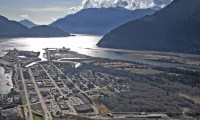Potential Drainage Issues with Landscape on Slab Including Green Roofs
Does your development have landscaping that directs runoff to a watercourse or the District of Squamish (District) storm system? See the diagram above for examples. If so, you will likely need to treat the runoff before it leaves your property.
Plants need nutrients to grow and thrive, and landscaping soils are specifically designed with this in mind. When water passes through the soil it picks up some of these nutrients and transports them away from the landscaping. When the water goes directly into the ground, there are natural processes that absorb or treat the nutrients. But, when the stormwater discharges directly into watercourses such as streams, sloughs, rivers, or the ocean, or when it leads to the District storm system which consists of hard pipes and ditches that lead to watercourses, there is the potential for these nutrients to harm the environment and negatively affect fish health.
This is why the District requires that all stormwater runoff from private property must meet Federal and Provincial Regulations and Guidelines. If stormwater runoff does not meet the requirements, it may delay issuance of Substantial Performance or release of associated security bonding. The key guidelines can be found here:
- CCME Guidelines: https://www.ccme.ca/en/resources/canadian_environmental_quality_guidelines/
- BC Guidelines: https://www2.gov.bc.ca/gov/content/environment/air-land-water/water/water-quality/water-quality-guidelines/approved-water-quality-guidelines
The District has been working with soil providers, landscape contractors, and developers to determine whether alternative soils could be used to avoid the need for treatment. Thus far, it appears that low nutrient soils may decrease nutrient concentrations in runoff, but will not bring the runoff into compliance. Therefore, in situations where landscaping runoff drains directly to a watercourse or the District’s storm system some form of water treatment is required in order to meet the applicable water quality requirements.
Types of treatment could include mechanical filtration in which drainage is routed through a media that pulls nutrients from the water, bio filtration in which drainage is passed through a porous material with organics growing on it that consume the nutrients, or infiltration into the ground.
The District recognizes that, under the right conditions, nutrients within the runoff from a single development may not cause eutrophication, algae growth or other detriment to the receiving waters. However, given the high levels of nutrient loading that have been observed in water quality tests, the cumulative effect of nutrient loading from many development sites, and the occurrence of algae blooms within the District and Howe Sound, the District is enforcing Provincial and Federal water quality guidelines.
Due to the complexities listed above, the District cannot confirm acceptable levels of nutrient loading in runoff for specific locations and is, therefore, relying on regulations and guidelines published by the Provincial and Federal agencies. In lieu of a detailed environmental impact study for a given watercourse, these guidelines provide appropriate targets to ensure minimal negative impact to the environment.
Questions? Please contact the Engineering Department for more information.
December 20, 2019

